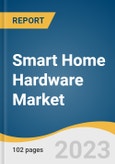The global smart home hardware market size is expected to reach USD 180.85 billion by 2030, expanding at a 14.3% CAGR from 2023 to 2030. With the proliferation of smartphones and other mobile devices, homeowners are looking for ways to control their homes remotely and conveniently. Smart home devices provide them with remote access to various home appliances and systems, including lighting, security, temperature control, and entertainment. Another smart home hardware growth driver is the increasing awareness of energy conservation and the need for sustainable living. Smart home devices are designed to be energy-efficient and environmentally friendly, making them attractive to consumers concerned about reducing their maintenance costs, and subsequently, carbon footprint.
Smart appliances such as refrigerators and dishwashers are equipped with features such as Wi-Fi and mobile connectivity, artificial intelligence integration, touchscreen controls, attached cameras inside to scan food types for refrigeration purposes, and more. Additionally, the robust mobile penetration rate and connectivity options such as mobile data or Wi-Fi increase the demand for the segment.
For instance, in May 2022, Samsung Electronics Ltd launched its smart washing machine with artificial intelligence, mobile application connectivity, and support. Besides, in August 2022, Samsung Electronics Ltd. launched its smart refrigerators with an inbuilt Bixby assistant in India. The refrigerators recognize voice commands and offer personalized information. Additionally, it is convenient for customers to monitor the refrigerator remotely via mobile and in-built use camera to digitally label food products with expiry dates.
The COVID-19 pandemic has also contributed to the growth of the smart home industry as more people are spending time at home and looking for ways to make their homes more comfortable and convenient. With the rise of remote work and the need for more connected devices, the demand for smart home hardware is anticipated to grow in the forecast period. Additionally, as people spend more time at home, there has been an increased demand for smart home devices that make life easier, more convenient, and safer.
For instance, the Indian Government’s Smart Cities mission, which aims to transform urban areas into technologically advanced and sustainable cities, also drives the growth of India's smart home hardware market. This initiative has increased homeowners' adoption of smart home devices as they seek to create more efficient and eco-friendly homes.
Smart appliances such as refrigerators and dishwashers are equipped with features such as Wi-Fi and mobile connectivity, artificial intelligence integration, touchscreen controls, attached cameras inside to scan food types for refrigeration purposes, and more. Additionally, the robust mobile penetration rate and connectivity options such as mobile data or Wi-Fi increase the demand for the segment.
For instance, in May 2022, Samsung Electronics Ltd launched its smart washing machine with artificial intelligence, mobile application connectivity, and support. Besides, in August 2022, Samsung Electronics Ltd. launched its smart refrigerators with an inbuilt Bixby assistant in India. The refrigerators recognize voice commands and offer personalized information. Additionally, it is convenient for customers to monitor the refrigerator remotely via mobile and in-built use camera to digitally label food products with expiry dates.
The COVID-19 pandemic has also contributed to the growth of the smart home industry as more people are spending time at home and looking for ways to make their homes more comfortable and convenient. With the rise of remote work and the need for more connected devices, the demand for smart home hardware is anticipated to grow in the forecast period. Additionally, as people spend more time at home, there has been an increased demand for smart home devices that make life easier, more convenient, and safer.
For instance, the Indian Government’s Smart Cities mission, which aims to transform urban areas into technologically advanced and sustainable cities, also drives the growth of India's smart home hardware market. This initiative has increased homeowners' adoption of smart home devices as they seek to create more efficient and eco-friendly homes.
Smart Home Hardware Market Report Highlights
- The smart appliances segment led the market in 2022, accounting for over 36% of the global revenue due to the increasing development of IoT technology. The IoT, driven by certain influential technological developments, is on its way to becoming the next technological wave
- The smart kitchen appliances sub-segment of smart appliances segment led the market in 2022, accounting for over 50% share of the global lighting controls revenue. Several factors are driving the growth of smart kitchen appliances, including advances in electronics, sensor technology, wireless technology, LED adoption, and smart street lighting
- The HVAC sub-segment of the smart appliances segment is predicted to foresee significant growth in the forecast years. The HVAC market continues to grow due to constructional growth in developing and developed regions
- The North America region held the largest revenue share of over 38% in 2022. The growing demand for low-carbon-emission-oriented and energy-saving solutions propels the smart home hardware industry in the region
Table of Contents
Chapter 1 Methodology And Scope
Chapter 2 Executive Summary
Chapter 3 Smart Home Hardware Market Variables And Trends
Chapter 4 Consumer Behavior Analysis
Chapter 5 Smart Home Hardware Market: Type Estimates & Trend Analysis
Chapter 6 Smart Home Hardware Market: Regional Estimates & Trend Analysis
Chapter 7 Smart Home Hardware Market - Competitive Landscape
List of Tables
List of Figures
Companies Mentioned
- Google LLC
- Amazon.Com Inc.
- Honeywell Corporation Inc.
- Schneider Electric SE
- Johnson Control Inc.
- ABB Ltd.
- Legrand
- Panasonic Corporation
- Samsung Electronics Co. Ltd.
- General Electric Company
Methodology

LOADING...
Table Information
| Report Attribute | Details |
|---|---|
| No. of Pages | 102 |
| Published | May 2023 |
| Forecast Period | 2022 - 2030 |
| Estimated Market Value ( USD | $ 61.73 Billion |
| Forecasted Market Value ( USD | $ 180.85 Billion |
| Compound Annual Growth Rate | 14.3% |
| Regions Covered | Global |
| No. of Companies Mentioned | 10 |









